
table of contents
- Gardening made easy
- Choose the right location
- Size of the beds
- Prepare the soil properly
- Mixed culture cultivation
- Care and harvest properly
- Don't forget crop rotation
- Vegetables for beginners
Vegetables from your own garden are not only healthy, fresh and crunchy, but growing them is also fun. With a few tips and the right vegetables, even beginners can do it.
Gardening made easy
If you have been thinking about creating your own vegetable garden for a long time, then you've come to the right place. Growing fresh vegetables is not only easy on the wallet, it also creates exercise in the fresh air and is also really fun. Usually, you don't even need a plot of land to grow vegetables. A good harvest can take place even in a small space. It can even be grown in pots and pans on the balcony or terrace. If you tackle it correctly, you can grow it without any problems. Even beginners can get a good harvest. Below are a few tips that should be observed.
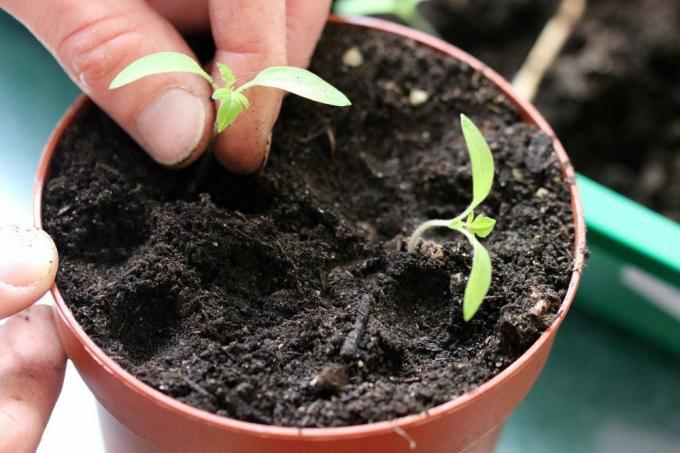
Choose the right location
Of course, a vegetable patch cannot just be laid out anywhere in the garden. When choosing the location, it is important to consider the needs of the plants so that they will thrive. The place should:
- be bright and sheltered from the wind
- but no blazing midday sun
- ideal for potted cultivation to the south
In the beginning, the cultivation should be started small. Usually a few rows are enough.
Size of the beds
At first, one or two beds are perfectly adequate. These shouldn't be too big either. A bed size of:
- Width 120 cm
- Length about 200 cm
A bed should always be easy to work on from all sides. Paths must be planned between the individual beds:
- 80 to 100 cm wide main path
- so enough space for wheelbarrows etc.
- at least 30 cm between individual rows of beds
A raised bed would also be ideal for cultivation. This is very clear, extremely space-saving and is easy on your back when you work.
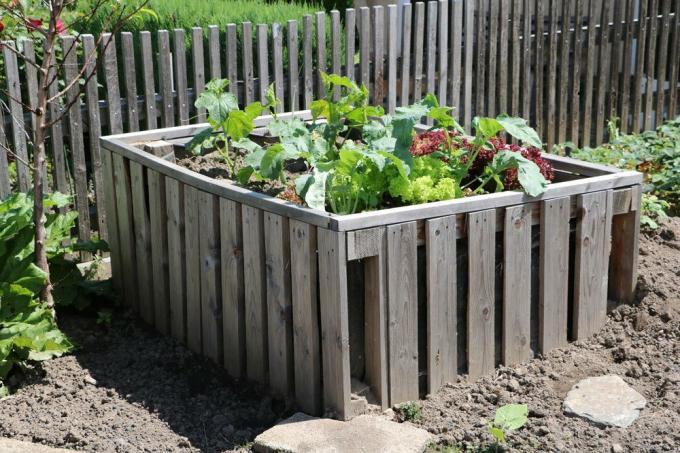
Prepare the soil properly
The nature of the soil is crucial for growing vegetables. This should be tested in advance. A pH value in the neutral range is optimal. Test strips are available from specialist retailers to measure the value. If the soil is in the acidic range, adding lime can help. However, if it is too alkaline, soil should be upgraded with the help of compost or manure. Ripe compost must also be regularly worked into the soil before each cultivation. This is not only used for fertilization, but also to maintain the soil structure.
In addition, the soil must be well loosened and weed-free. If possible, it should be dug up as early as the autumn of the previous year. The soil can settle over the winter and the freezing process causes the water in the soil to freeze and expand. This causes larger clods of earth to be blown up. The earth becomes loose and crumbly and the soil is well aerated.
Furthermore, it is necessary to check the permeability of the soil, because waterlogging inevitably means the "death" of the plants. To do this, the soil is simply watered sufficiently. The next day, simply squeeze a handful of soil and the drainage capacity can be seen. If there is still liquid escaping, the soil must be treated with compost.
Mixed culture cultivation
Not to be forgotten is the right combination of plants in a bed. Different types of vegetables with different cultivation times and from different plant families should always be grown. The advantage is:
- Plants benefit from each other in terms of health and growth
- no one-sided withdrawal of nutrients from the soil

Note: Good neighbors include French beans, peas, carrots, radishes, tomatoes, spinach, lettuce and beetroot. On the other hand, onions and potatoes don't go very well.
Care and harvest properly
But sowing or planting is far from over. Only then does it really start. In order for the vegetable plants to develop well and a rich harvest can be expected, it is necessary:
- regular watering, but moderate
- check the top layer of soil for moisture
- water when dry
- when heated, 10 to 20 liters per square meter
- Avoid waterlogging
- loosen the soil regularly
- remove weeds
- fertilization
- Frequency different for each type of vegetable
- Gift of organic fertilizer
- Long-term fertilizers such as horn shavings have been tried and tested
- releases nutrients slowly and evenly
- thus at least supply of nutrients for three months

As a rule, the different types of vegetables are then harvested in several stages. If only individual fruits are harvested, they should be harvested daily. In this way, the plant is regularly stimulated to produce new fruits. Other varieties, on the other hand, are harvested whole and as required, such as lettuce or cabbage.
Note: Young seedlings often need smaller amounts of water. Afterwards, a thorough watering once a week is sufficient.
Don't forget crop rotation
In every year of cultivation it is necessary to change the location of the individual varieties on the bed. In other words, they should definitely not be planted in the same place again. This is required to:
- to ensure a good harvest
- Varieties have different nutritional requirements
- Prevent leaching of the soil
- Avoid diseases and the spread of plant pests
It is advisable to keep an overview of the entire cultivation of the individual years, otherwise the overview can be lost very quickly. It should also be noted that not all vegetables are compatible with the previous crop. You should be thoroughly informed about which vegetable plants are particularly suitable as pre- or post-crops.
Note: It is recommended that vegetables are grown in the same place every three years.

Vegetables for beginners
Choosing the right variety is particularly important for “newbies”. In no case should many vegetables be grown at once. It's better to start small and increase the number of varieties over the years. There are different varieties where normally no great previous knowledge is required and, if necessary, they can also be grown in pots and tubs. These are also:
- easy to care for and robust
- undemanding in terms of soil quality
- not susceptible to diseases and pests
- well suited for mixed culture
- tolerate light periods of drought or rainfall
- are partially insensitive to cold
However, it is important to ensure the correct sowing dates even with such beginner varieties. These must not be done too early, as the seeds will then germinate slowly or partially fail. The seedlings are then also more susceptible to pests such as snails. The necessary distances between the individual plants are also important. You need space for healthy growth. In some cases, a preculture in the house on the windowsill in early spring is also necessary. All this information can be found on the seed bags. We have put together some popular vegetables for beginners below.
Radishes (Raphanus sativus)
Radishes are child's play to grow. They should be sown between slower growing vegetables such as carrots or parsley. They are used to mark the rows. Not only are the tender tubers edible, but also the roots and leaves. There are different types, red round or oblong and white, which are known as icicles. Radishes are quite undemanding and only need a few nutrients. Please note when adding:

- Sow March to September
- directly outdoors in rows
- Floor temperature 6 to 8 ° C
- Seed depth 0.5 to 1 cm
- Cover with soil, press down and keep moist
- Row spacing 15 cm
- within the row 5 cm
- Germination 5 to 8 days
- Cold germ
- Cold period of 7 days at 5 to 10 ° C is favorable
- sunny to partially shaded
- nutritious, loose soil
- keep well moist
- loosen the soil every now and then
- Protection against snails is important
- Harvest 3 to 4 weeks after sowing
Note: If the soil is too dry or wet, the red tubers will burst.
Lettuce (Lactuca sativa)
There are also different types, light and dark colors and shapes. The lettuce and pick lettuce are popular for growing with beginners. There are spring and summer varieties of lettuce, the whole head is always harvested. In contrast, only the outer leaves of the lettuce are harvested. The heart leaves have to stop so that the lettuce can always grow back. Therefore, lettuce can also be harvested continuously. Please note:

- Sow March to August / September
- flat in rows
- Floor temperature 10 to 20 ° C
- Light germs
- Sowing depth max. 0.5 cm
- cover only lightly with soil
- Germination 7 to 12 days
- Row spacing 25 to 30 cm
- within the row 25 cm
- sunny to partially shaded
- no blazing midday sun
- humic, evenly moist soil
- sensitive to salt
- Harvest May to September
- water well
- Snail protection required
The trade also offers pre-grown young plants.
Note: Salad works well in a mixed culture with tomatoes, onions and cucumbers.
Swiss chard (Beta vulgaris)
A distinction is made between stem and leaf chard. There are varieties with white, red and yellow stems. The stalks can be cooked like asparagus and the leaves like spinach. Swiss chard is heat - and also cold - resistant. The whole plant should never be harvested, only the outer leaves, then a regular harvest is guaranteed. Please also note:

- Sow in March / April directly outdoors
- Chard leaf:
- 3 cm deep
- Row spacing 30 cm
- within the row 15 to 20 cm
- Harvest from June
- Chard:
- 3 cm deep
- Row spacing 40 cm
- within the row 25 to 30 cm
- Harvest from the end of June / beginning of July
- sunny to shady
- no blazing midday sun
- fresh, moist soil
- protect young plants from snails
- water regularly
- Keep beds weed-free
Note: An additional small amount of fertilizer should be given every 14 days.
French beans (Phaseolus vulgaris)
In addition to the French beans, there are also runner beans. These are cultivated in the same way as French beans, but they need a climbing aid. Beans can be used in many ways. They are suitable for fresh consumption in salads, soups and as a vegetable side dish, but also for freezing. Never consume raw, as the kernels and bean pods are poisonous. The toxins only break down when heated to 90 ° C. Please note the following when adding:

- Sow in rows from late May to July
- Place 3 to 6 seeds in a hole
- Distance within the row 40 cm
- Row spacing at least 50 cm
- Seed depth 3 cm
- Floor temperature 15 to 20 ° C
- Germination after 8 to 10 days
- Sun to partial shade
- water regularly
- Keep beds weed-free
- Harvest 10 to 12 weeks after sowing until frost
Once the beans have ripened, however, they should be harvested regularly, so that the plants are stimulated to flower again. In the first few weeks after sowing, however, it is advisable to cover the rows with transparent fleece to protect against bird damage.
Tip: When the plants have reached a height of 10 to 15 cm, pile them up with a hand's breadth of soil.
Spinach (Spinacia oleracea)
Spinach can be harvested in summer, but is also a popular winter vegetable and suitable for wintering in the bed. Spinach is used steamed, raw or as a salad. Please note:
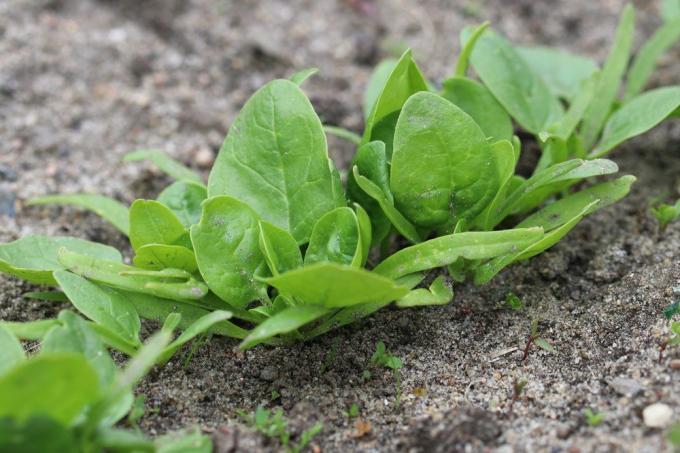
- Sowing March to May or August to October directly outdoors
- Sowing depth 1 to 2 cm
- Floor temperature 10 to 20 ° C
- Row spacing 25 to 30 cm
- within the row 5 to 7 cm
- sunny to partially shaded
- loose, humus soil
- water regularly
- Harvest 10 to 12 weeks after sowing
Tip: Cover the seeds with a light, translucent fleece to protect them from bird damage.
Zucchini (Cucurbita pepo ssp. pepo)
Zucchini are very popular. Not only the fruits are edible, but also the flowers. The plants do, however, need some space. One plant is enough to provide fruit for a small family well into autumn. The culture is simple:
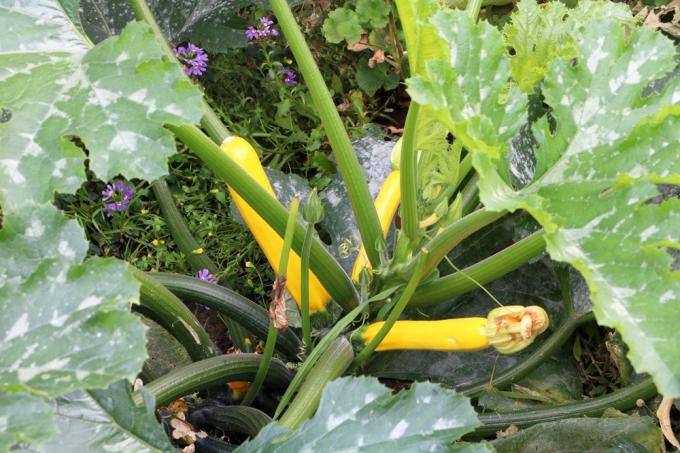
- Space requirement at least 1 square meter per plant
- Pre-culture in the house from March to April
- put two grains in a saucepan
- Cover with soil three times the seed thickness
- press down and keep moist
- Plant out in the field at the end of May
- alternatively, direct sowing outdoors from the end of May
- Floor temperature 18 to 25 ° C
- Germination after 6 to 10 days
- Sun to partial shade
- no blazing midday sun
- nutritious soil
- ideal compost heap
- Harvest 10 to 12 weeks after sowing by September
Tomatoes (Solanum lycopersicum)
In principle, tomatoes grow by themselves if they have a rainproof place. The red fruits can be prepared in different ways in the kitchen. However, the following must be observed when cultivating:

- Pre-culture in the house
- Sow March to April
- Pre-soak seeds 24 hours for better germination
- Sow in pots
- Seed depth 1 cm
- keep well moist
- Floor temperature 22 to 25 ° C
- Germination time 10 to 21 days
- Plant out in the field at the end of May
- Row spacing 80 cm
- within the row 60 cm
- humus, nutrient-rich, deep soils
- full sun and sheltered from the wind
- water a lot and fertilize regularly (special tomato fertilizers)
- Side shoots regularly break out of the leaf axils
- Support required
Pre-grown young plants are also available in stores.
Tip: For watering, put a clay pot in the soil and fill it with water.
Kohlrabi (Brassica oleracea var. gongylodes)
This is a popular spring vegetable. It is suitable for raw consumption, for steaming or freezing. The cultivation is very easy:

- Sow from March to April in cold frames or bowls
- Direct sowing outdoors from May to June
- Sowing depth 1 to 2 cm
- Distance 30 x 30 cm
- Floor temperature 20 to 25 ° C
- Germination time 8 to 15 days
- sunny
- nutrient-rich, loose soil
- water and fertilize regularly
- Young plants are sensitive to cold
- Subsequent sowing is possible every 3 to 4 weeks
- Harvest July to October
- Change location in the following year
Tip: Very large tubers can quickly become woody, so always harvest in good time.
Onions (Allium cepa L.)
Onions should not be missing in any kitchen. You can either be sown yourself, then some patience is required. However, it is quicker and easier to use onion sets. In terms of culture, you can't go wrong with this:
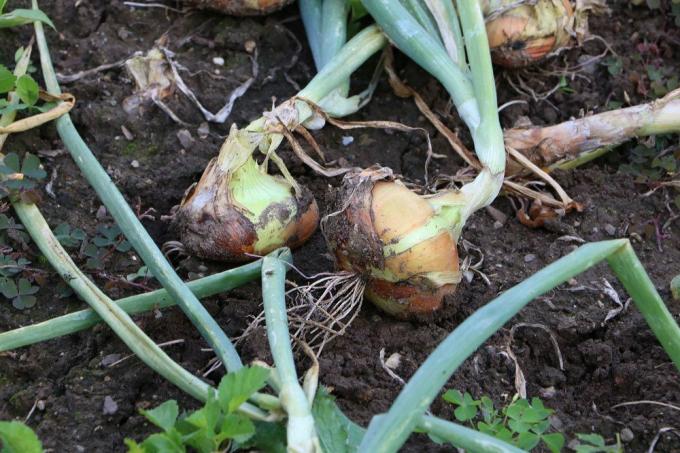
- Cultivation in rows
- From the middle of March, put one onion halfway into the ground
- Distance 15 cm
- loose, humus soil
- sunny to partially shaded
- Mixed culture with carrots cheap
- pour only when it is dry
- loosen the soil every now and then
- Eliminate weeds
When the leaves begin to wither in autumn, pull onions out of the ground. You should then lie on the ground for a few more days, provided it is not raining. This then extends the shelf life over the winter.
Tip: The foliage of the onion is also popular in the kitchen. However, it should never be cut off completely, otherwise the onion will stop growing.
Potatoes (Solanum tuberosum)
Potatoes are ideal as a first crop on a new bed. This requires some space. Special seed potatoes are used. There are different varieties here. The cultivation is also well suited for beginners.
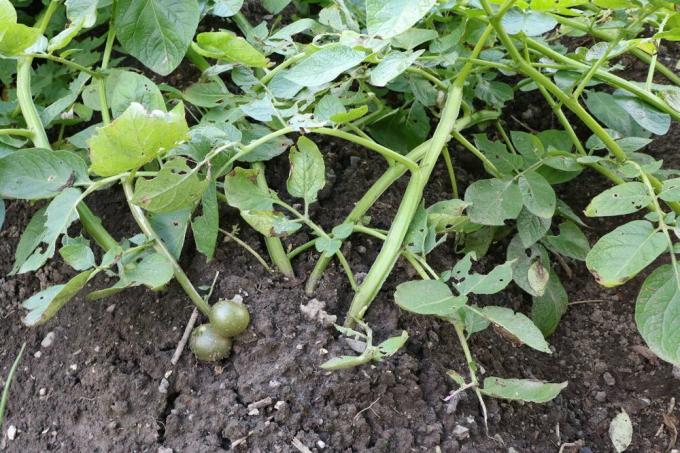
- after the ice saints in May, place potatoes in furrows
- Well loosened soil necessary
- Place the tubers 15 cm deep
- cover with earth
- pile up when the shoots are 20 cm high
- thereby stimulating growth
- Pull soil up to the side of the plant
- a small dam should be built
- Remove weeds regularly at first
- hardly any maintenance required for larger plants
- water in case of prolonged drought
- no cultivation together with tomatoes
- thereby prevention of late blight
- alternatively cultivation in large pots, buckets or sacks
- Fill the container 20 cm high with soil
- Put in 4 to 5 potatoes
- Put 10 cm of soil over it
- when the shoots are 5 cm high, top up with soil
The potatoes are ready for harvest when the leaves begin to wither.
Note: Colorado beetles like to attack the foliage. These must therefore be searched regularly.
